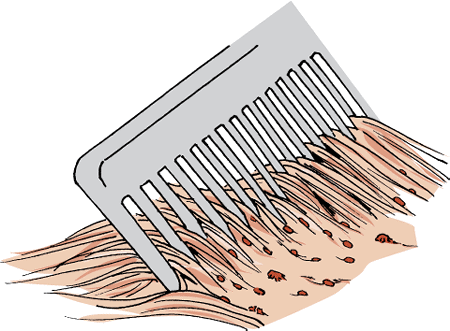Lice of Cats
- Skin Disorders of Cats
- Structure of the Skin in Cats
- Dermatitis and Dermatologic Problems in Cats
- Diagnosis of Skin Disorders in Cats
- Treatment of Skin Disorders in Cats
- Congenital and Inherited Skin Disorders of Cats
- Allergies of Cats
- Eosinophilic Granuloma Complex in Cats
- Fleas of Cats
- Flies and Mosquitoes of Cats
- Hair Loss (Alopecia) in Cats
- Hives and Rashes (Urticaria) in Cats
- Itching (Pruritus) in Cats
- Lice of Cats
- Mite Infestation (Mange, Acariasis, Scabies) of Cats
- Parasitic Worms of the Skin in Cats
- Photosensitization in Cats
- Pox Infection in Cats
- Pyoderma in Cats
- Ringworm (Dermatophytosis) in Cats
- Ticks of Cats
- Tumors of the Skin in Cats
- Whole-body Disorders that Affect the Skin in Cats
Also see professional content regarding lice.
Lice are small, flightless insects that live in the hair or feathers of animals and people. Most lice are of the biting or chewing type (order Mallophaga), including the cat louse (Felicola subrostrata). Lice are most often seen on older, longhaired cats that are no longer able to groom themselves.
Lice live within the environment provided by the skin and hair. They move from host to host by direct contact. In temperate regions, lice are most common during the colder months and hard to find in the summer. Most Mallophaga lice have definite preferences as to their hosts: they will often live on only one species or several closely related species.
Lice have claws on their legs that are adapted for clinging to hair. Females glue their eggs, known as nits, to the hairs of the host near the skin. The nits are tightly attached and ordinary shampooing will not dislodge them. It takes about 3 to 4 weeks for most lice to go from nit to adult.
The first signs that your cat may have lice are scratching, biting, and rubbing of infested areas. If the lice are abundant, the hair might also be matted. Usually, diagnosis is made by seeing lice on the infested cat. Parting the hair often reveals the lice. Lice are active and can be seen moving through the hair.
Using a fine-toothed comb to dislodge nits is a tedious process that will not kill lice that have hatched. Cats and other pets are more frequently treated with dips, washes, sprays, or dusts that kill lice. Your veterinarian can recommend an appropriate control product for your pet and provide directions for its use (Veterinary.heading on page Lice of Dogs).
The lice that infest cats and other pets are not normally attracted to humans. Therefore, while care in dealing with the lice infesting your pet is recommended, owners should understand that people rarely get lice from their pets.
Resources In This Article
- Skin Disorders of Cats
- Structure of the Skin in Cats
- Dermatitis and Dermatologic Problems in Cats
- Diagnosis of Skin Disorders in Cats
- Treatment of Skin Disorders in Cats
- Congenital and Inherited Skin Disorders of Cats
- Allergies of Cats
- Eosinophilic Granuloma Complex in Cats
- Fleas of Cats
- Flies and Mosquitoes of Cats
- Hair Loss (Alopecia) in Cats
- Hives and Rashes (Urticaria) in Cats
- Itching (Pruritus) in Cats
- Lice of Cats
- Mite Infestation (Mange, Acariasis, Scabies) of Cats
- Parasitic Worms of the Skin in Cats
- Photosensitization in Cats
- Pox Infection in Cats
- Pyoderma in Cats
- Ringworm (Dermatophytosis) in Cats
- Ticks of Cats
- Tumors of the Skin in Cats
- Whole-body Disorders that Affect the Skin in Cats







